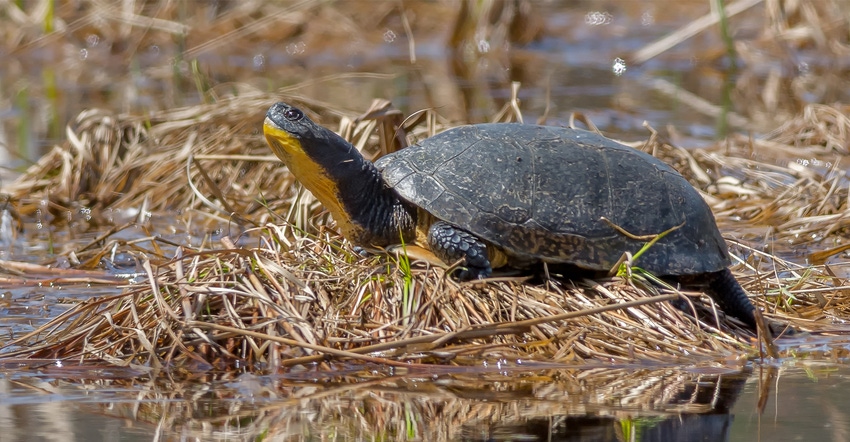February 17, 2021

While there are no oceans or seas in Iowa, and some 95% of its natural wetlands were converted to agricultural cropland over the past two centuries, the state is bordered by rivers and has an abundance of wetlands, lakes, ponds and even standing water in farm fields that provide habitat for a huge variety of creatures.
In a recent webinar hosted by Iowa Learning Farms, Adam Janke, Extension wildlife specialist and assistant professor at Iowa State University, highlighted some of the cast of characters found in Iowa's aquatic ecosystems.
Related: Interns help expand water, natural resource offerings
Janke selected 27 species that are found in Iowa to represent the diversity, which spans insects, mammals, reptiles, fish and others. He began the presentation with the odd story of the reintroduction of river otters to the state in 1985.
"A key player in this effort was a decidedly non-aquatic species, the wild turkey," Janke said. "Iowa statutes prevented the direct purchase of river otters, so a three-way trade was created in which wild turkeys were sold to Kentucky to support reintroduction efforts there. Kentucky then purchased the river otters from a farmer in Louisiana and had them shipped to Iowa. They had to get creative at the start, but the effort was an astounding success. River otters are now a common Iowa wildlife species, found in each county in the state and supporting an annual trapping season."
Of the 27 species highlighted in the webinar, many were listed as threatened or endangered by the state of Iowa. Declines in populations and threats to these species are related to long-term changes in the landscape and waterscape of the state. Continuous efforts to improve water quality through initiatives such as the Iowa Nutrient Reduction Strategy are helping to improve conditions that will better support these and many other aquatic species.
Diverse wildlife
Some aquatic species spend their entire life cycles submerged in Iowa waters, while others stop by during local, regional or globe-spanning migrations.
Birds such as the pectoral sandpiper migrate from arctic breeding grounds to near the Antarctic continent, but depend on transitory water features in Iowa — such as standing spring melt water in farm fields — to help fuel their northward migration in the spring. These shore birds are among some 53 different species that have been counted in farmed wetlands and standing water in Iowa farm fields during the spring migration season.
Other species that make big movements include the lake sturgeon, some of which travel more than 100 miles, to fish and turtles that will travel tens of miles throughout a year. And highly visible flocks of Canada geese and American white pelicans also rely on Iowa waters for breeding grounds, winter respite and migration stopovers.
Mussels, with around 46 species native to Iowa waters, stay relatively stationary and play an important role in filtering water. In response to a question about harmful mussels, Janke noted that the Midwest is a hot spot for mussel diversity and was certain to clarify that all native species are positive contributors to their aquatic ecosystems and are actually threatened by invasive species such as the zebra mussel.
"The zebra mussel gets a lot of attention because of its destructive nature," Janke said. "It has moved successfully on boats and trailers, in bilge water, and even in bait buckets. Attaching to hard surfaces, the zebra will even attach to helpful mussels such as the Higgins-eye pearlymussel and kill them."
Stepping out of the water and into adjacent prairie and forest, Janke turned to creatures such as the wood turtle, an endangered species that takes advantage of forest prairie and wetlands. Blanding's turtle is another species that spends much of its time in the water but moves to uplands to nest.
Another animal dependent on the river and forest ecosystem is the belted kingfisher, a bird that feeds on aquatic wildlife. This unique bird is one of the few species in Iowa that nests in the ground, excavating their nests into river and stream banks.
Wetland dwellers
Different wet lands, from soggy, highly saturated soils in a fen, to the large border rivers framing the state, provide unique environments that support equally unique species. One example of this is the Baltimore checkerspot, a butterfly that depends on turtlehead plants, which only grow in fens, for survival. Reductions in turtlehead abundance have directly affected the butterfly's population, landing it on the Iowa endangered list.
Janke's list of wildlife also included salamanders, snakes, damselflies and dragonflies, fish, and a category of birds called secretive marsh birds. Sharing a video of the sora, one such secretive marsh bird, Janke said that the only way to know you are near one of these birds is by recognizing its unique call.
Wetland mammals such as the muskrat and beaver were also discussed in the webinar. "Muskrats are one species that is recognized for the benefits other creatures enjoy from the ways in which muskrats manipulate their environment," Janke said. "The reestablishment of trumpeter swans has been well supported by their use of abandoned muskrat huts as nesting sites. And the still waters held back by beaver dams create excellent environments for Iowa's only native trout species, the brook trout."
Closing with a variety of references for additional learning and exploration, Janke admitted that the webinar only scratched the surface of the quantities and variety of aquatic wildlife in Iowa. To view the webinar and learn more about this topic, visit Iowa Learning Farms.
Pierce is an extension program specialist with a focus on water quality with Iowa Learning Farms and Water Rocks.
You May Also Like




